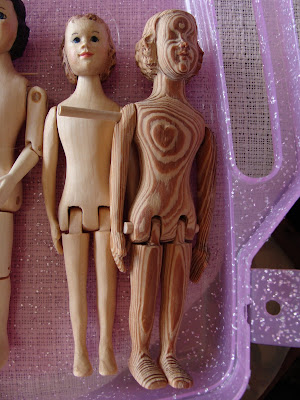Here are Jill's notes from her informative A.M. program. Her photos of A.M. dolls are posted above.
Armand Marseille dolls
doll club program Oct. 3, 2010
I have always found Armand Marseille dolls pretty, and they are practical in terms of availability and cost!
The period of the late 19th century through the early 20th century is often called the GOLDEN AGE of dolls. For a span of approximately 30 years, Germany was the doll making capital. Up until World War I, Thuringia, Koppelsdorf (an area in East Germany) supplied nearly 80% of the world production of dolls. Another factor contributing to the growth of doll making in Germany was that it was subsidized by the government. Also, the industry grew out of a work at home base so that anyone could get involved. Armand Marseille of Koppelsdorf at one time had the largest output of dolls of any company.
Located in Koppelsdorf, in the Thuringia region of Germany, the Armand Marseille doll company was at the heart of the German doll making revolution in the 1890’s manufacturing 1000 bisque doll heads a day from 1900-1930.
– Armand Marseille was born in St. Petersburg, Russian in 1856 – he was a butcher before being a successful doll maker. He was of Huguenot descent – hence, the French sound last name.
Marseille and his family moved to Germany in the 1860s – it was in 1885 that he bought the Koppelsdorf factory – and he changed his first name to Herman, from Armand. He also married Solveigh Heubach, sisiter of Ernest Heubach in 1891 – the Heubach connection would tend to explain why some fine AM dolls have a horseshoe mark on them - a mark which had historically been more commonly associated with the older Heubach firm.
By 1910 – 800 workers were in the factory and in home trade
Almost all of Armand Marseille’s doll heads were made of bisque – many other doll companies purchased AM doll heads. Doll bodies were generally made of composition or stuffed kid with bisque arms – interestingly, Armand Marseille did not make his own bodies.
American importers often called on AM-
4 of the largest NY importers sold AM dolls- Louis Wolf, Butler Brothers, Louis Amberg, and George Borgfeldt.
AM dolls were sold as promotional dolls –
Dollar doll – upper thighs lengthened /ruffles on dresses
The AM factory made dolls in all price ranges – and made the doll heads according to the BUYER’s price range.
Montgomery Ward – ordered cheaper doll – quality cut accordingly.
vs.
Louis Wolf- “first quality” doll – face painting, clothing, etc... were better.
In 1915, Armand Marseille Jr.‘s daughter Beatrice married the son of Ernst Heubach, again linking the two doll producing families -
1919 – AM porcelain factory and Ernst Heubach porcelain factory became United Koppelsdorf Porcelain Factory. Still made separate heads even though they joined forces.
The AM factory was torn down in 1994.
500,600,700 – series – very nice quality dolls
370/390 – read p. 6 P. Smith book.
1892, 1894, 1895, 1897, 1899, 1900, 1901, 1902 – AM mark
above with Horse shoe – E. Heubach
many heads are D.E.P. (registered) or DRGM – incorporated German Co.
Patricia Smith in her book mentions that she has never seen an AM doll with pierced ears!
Perhaps the most famous work by AM was My Dream Baby (marked 341) of the 1920’s – which rivaled the famous Grace Storey Putnam’s Bye-lo Baby.
Marseille made the famous Queen Louise doll which was registered in the US in 1910 by Louis Wolfe and Co. – The bisque of the Queen Louise is extremely fine with pale coloring and sleep brown eyes. Various versions had either painted or mohair lashes while some eyebrows were glossy.
Finally, despite the wide availability and sometimes inferior quality of the Armand Marseille dolls, they have made doll collecting possible for people with limited budgets and created some exquisite, lovely dolls!




























